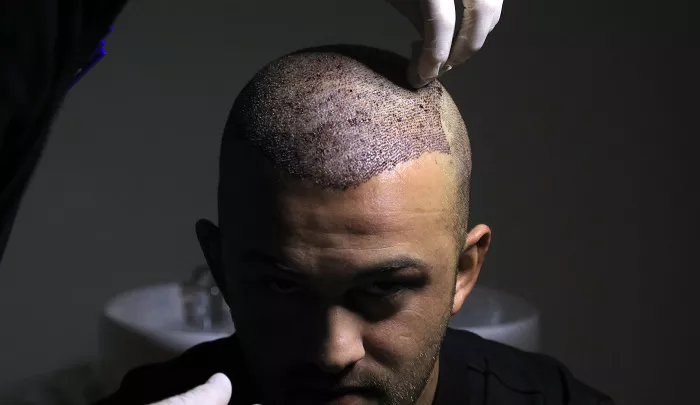After a hair transplant, the formation of scabs is a normal part of the healing process. However, it’s crucial to handle the removal of these scabs with great care to ensure the success of the transplant and the health of the newly transplanted hair follicles. Incorrect removal can lead to damage to the follicles, bleeding, or even infection.
Understanding the Scabbing Process
Why Scabs Form
Scabs form as a protective layer over the transplanted hair follicles. During the hair transplant procedure, the scalp undergoes trauma, whether it’s from follicular unit transplantation (FUT) with a strip of scalp being removed and sutured or follicular unit extraction (FUE) where individual follicles are extracted. The body’s natural response is to form a clot to stop any bleeding and then a scab to protect the area from external contaminants. This scab also helps in the initial stages of tissue repair.
The Role of Scabs in Healing
Scabs play an important role in the healing process. They provide a stable environment for the new hair follicles to start integrating with the surrounding tissue. Underneath the scab, the body is working to form new blood vessels and connective tissue to support the growth of the transplanted hair. The scab acts as a shield during this delicate time, but as the healing progresses, it will naturally fall off when the new tissue is ready.
When to Start Dealing with Scabs
Initial Healing Period
In the first few days after a hair transplant, it’s essential to leave the scabs completely alone. The transplanted follicles are in a very fragile state during this time. The surgical sites are just starting to heal, and any attempt to remove the scabs prematurely can disrupt the healing process. This can cause bleeding, which can dislodge the newly transplanted follicles.
It’s usually best to wait at least 3 – 5 days after the transplant before considering any form of scab management.
Signs of Readiness
As the days pass, you can start to look for signs that the scabs are ready to be removed or are starting to come off on their own. One sign is that the scabs may start to loosen around the edges.
They may also appear drier and less firmly attached to the scalp. Additionally, if there is no pain or bleeding when gently touching the area around the scab, it could be an indication that it’s approaching the time for removal. However, this should still be done with extreme caution.
Gentle Cleaning Methods
Using Saline Solution
Saline solution is one of the safest and most recommended ways to help with scab removal. You can make a simple saline solution at home by mixing a teaspoon of salt in a cup of warm distilled water.
Gently dab a cotton swab or a soft, clean cloth soaked in the saline solution onto the scab. The saline solution helps to moisten the scab, making it easier to come off without pulling on the hair follicles. It also has antiseptic properties, which can help prevent infection. Be sure to use a very light touch and avoid rubbing vigorously. Start from the edges of the scab and work your way inwards gradually.
Lukewarm Water Rinses
Lukewarm water can also be used for gentle scab removal. When washing your hair (usually after a few days as per your doctor’s instructions), let the lukewarm water flow over the scalp. The water can help to soften the scabs. However, avoid using high – pressure water, such as from a strong showerhead, as this can be too forceful and dislodge the follicles. After rinsing with water, you can gently pat the scalp dry with a soft towel. Do not rub the scalp as this can cause the scabs to be removed too quickly or cause trauma to the transplanted area.
Avoiding Harsh Approaches
No Picking or Scratching
One of the most important things to remember is to never pick or scratch at the scabs. This can cause significant damage to the newly transplanted hair follicles. Even if the scabs are itchy or seem to be in the way, resist the urge to touch them with your fingernails. Picking can lead to bleeding, infection, and can even pull out the transplanted follicles, which would be detrimental to the success of the hair transplant.
Avoiding Harsh Chemicals
Do not use any harsh chemicals such as strong shampoos, alcohol – based solutions, or any products with abrasive ingredients to remove the scabs. These chemicals can irritate the scalp and the transplanted follicles. They can disrupt the delicate balance of the healing process and cause inflammation. Stick to gentle, doctor – recommended products for scalp care during the scab – removal phase.
Post – Scab Removal Care
Keeping the Scalp Clean
After the scabs have been removed, it’s important to keep the scalp clean to prevent infection.
Continue to use gentle cleaning methods with saline solution or mild shampoos as directed by your doctor. This helps to maintain a healthy environment for the transplanted hair follicles to continue their growth process.
Monitoring for Infection or Complications
Keep a close eye on the scalp for any signs of infection or other complications. Look for redness, swelling, increased pain, or any discharge from the scalp. If you notice any of these symptoms, contact your doctor immediately. Early detection and treatment of any issues can ensure the best possible outcome for your hair transplant.
Conclusion
Removing scabs after a hair transplant requires patience, gentleness, and careful attention to the healing process. By following the proper methods and avoiding harsh or hasty approaches, you can help ensure that the newly transplanted hair follicles have the best chance of thriving. Always consult your doctor for specific instructions based on your individual hair transplant procedure and the progress of your healing. With proper care during the scab – removal phase, you can look forward to a successful hair transplant outcome with healthy hair growth.
Related topic:

